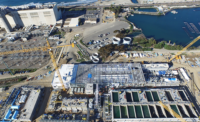Some preliminary construction work has begun on the controversial $1.9-billion, 120-mi Sunrise Powerlink transmission line project in the San Diego region.
Though more permitting and reports still need to be approved before the transmission lines can built, San Diego Gas & Electric says it will go ahead and start building a construction yard and office in Alpine and upgrade substations in the North County and Chula Vista.
The Sunrise Powerlink will tap into the various wind, solar and geothermal resources in the Imperial Valley, says SDG&E spokeswoman Jennifer Ramp. �We already have several contracts with developers who plan to build facilities out there and more are waiting for the line to be built,� she adds.
Ramp says that at least one contractor has been signed up for some work, PAR Electrical Contractors of Kansas City. In July, SDG&E received approval from the U.S. Forest Service.
�This key decision accelerates the momentum for the Sunrise Powerlink, a project that will create much needed jobs, lower greenhouse gas emissions and bolster reliability for the region�s power grid,� says Jessie J. Knight, Jr., chief executive officer of SDG&E. �This project will access vast, untapped sources of renewable power for the people of San Diego County and help create a cleaner, more environmentally-responsible future for the region.�
After a rigorous environmental review, the USFS issued a Record of Decision approving the construction, operation and maintenance of a 19-mi segment of the transmission line through the Cleveland National Forest.
The milestone decision joins key prior project approvals from the California Public Utilities Commission in late 2008 and the Department of the Interior�s Bureau of Land Management in early 2009. The SDG&E says the permitting process and environmental reviews for the Sunrise Powerlink represent the most comprehensive completed for a power line in California history.
When completed in 2012, the 500-kilovolt Sunrise Powerlink electric �superhighway� will have the capacity to carry at least 1,000 megawatts of clean power, or enough energy for 650,000 homes. The project will create 400 to 500 direct construction jobs and provide more than $100 million in annual energy savings.
The environmental review process, a collaborative effort between SDG&E, USFS and other federal, state and local agencies, has led to several modifications that will substantially reduce the environmental impacts of the project, including preserving sensitive resources within CNF. Even with these modifications, SDG&E says it recognizes there is opposition to the project and pending legal challenges, and is committed to working with the communities impacted by project construction.


Post a comment to this article
Report Abusive Comment